Highlights from the Next Generation Telecom Conference, Latin America
This Blog takes a deep dive into the big data issues facing service providers and provides a quick preview of EMC’s new, unique solution to solve big data in the Communications Industry.
For those of you that have been on an extended ocean cruise (for the past 2 years) and just got back to civilization, please consider the following:
Publication: The Wall Street Journal’s Special Report: CIO Network (January 22, 2013)
Best Quote: “We are drowning in data. We don’t have enough ability to analyze it.” – Chris Anderson, CEO, 3D Robotics
EMC partnered with IDG to dig into this trend for Network Service providers and found some interesting facts:
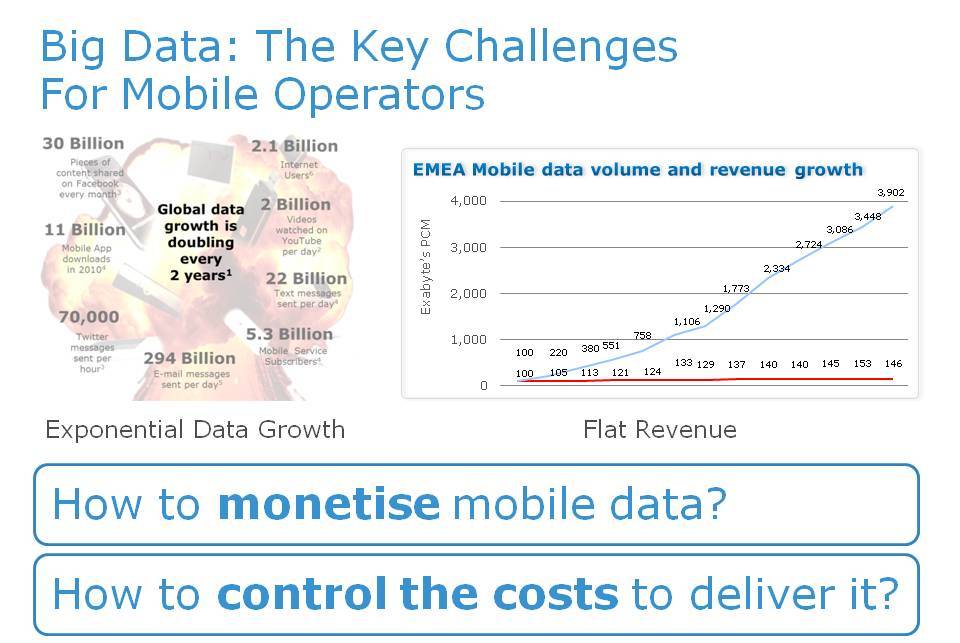
Alongside two of my colleagues, EMC facilitated a Service Provider workshop on this topic at the March 2013 Next Generation Telecom Conference in Panama City, Panama. We polled the audience and found uniform agreement on these trends. The Latin American Service Providers elaborated on the following concerns:
1) A Service Provider has more data to manage and analyze.
- Data generated by each subscriber growing, with more devices on the network and more data in the cloud.
- “The need to store and analyze data, particularly Call Detail Records (CDRs), is something we can’t deal with.”
- Our internal users are asking for more detailed data across longer periods of time to support deeper analysis.
- “We don’t have the compute power to process all this data.”
2) A Service Provider has more demanding business users.
- New business opportunities are causing demand for more real-time data at higher frequencies.
- My business users want to perform analytics using many other data sources, some unstructured and in the cloud.’
- “We don’t have enough skilled resources in IT to perform these analyses.”
3) The Network itself is the problem.
- Networks cannot scale at same rate of network data growth.
- “Networks are becoming bottlenecks for data transport back to a central hub.” This trend is particularly true in Latin America, where transport costs (inter- and intra-country) are a significant barrier that restrict and otherwise delay channels through which data is flowing.
4) A Service Provider has less time to react.
- Offerings such as location based services require reactions within seconds not minutes / hours.
- Increase in automation (machine learning, Software Defined Networks) will drive need for more real-time network data and analysis.
- “We need new ways to extract value from all this data.”
These issues are driving a major change in how network data should be managed and analyzed. EMC’s approach? Read on … in our view, the biggest single trend for 2013 is to move decision making much closer to the business event itself.
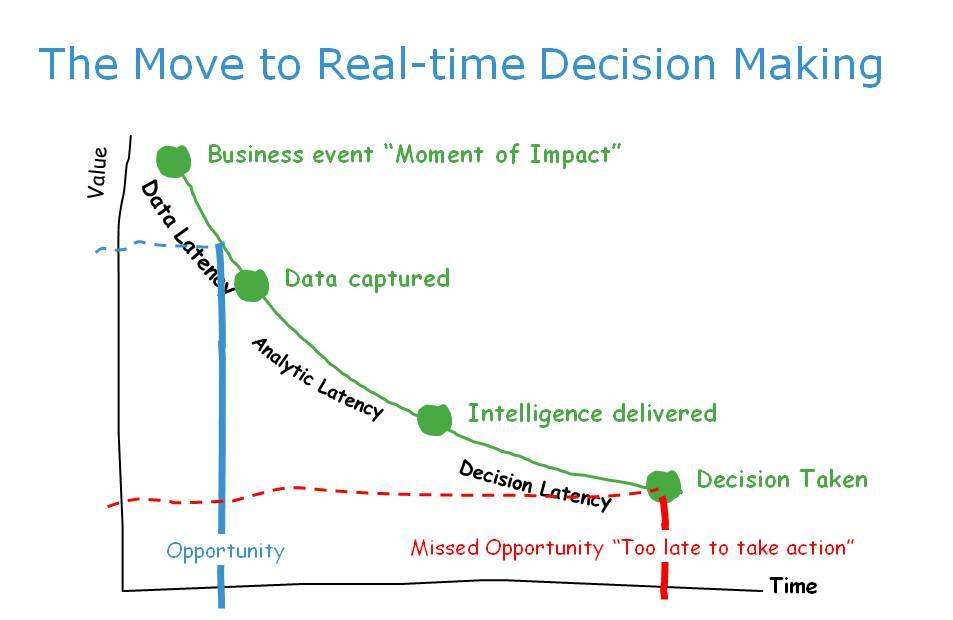
Why? Today’s IT systems and networks can cause delays in capturing the data and delivering the data to a traditional central hub (data warehouse) for processing. With the explosion of data, central hubs become data processing bottlenecks themselves, causing delays in processing and providing decision recommendations. As a result, the business misses an opportunity to take action.
Leading Service Providers will look for advanced techniques to move decision making closer to the “moment of impact” of a business event. This trend is as powerful and impactful as the dawn of the personal computer, moving computing capabilities out of central data hubs to the edge of the network and closer to the users.
Now that the problem is well defined, how do you tackle it? We at EMC are developing a new solution approach. The highlights:
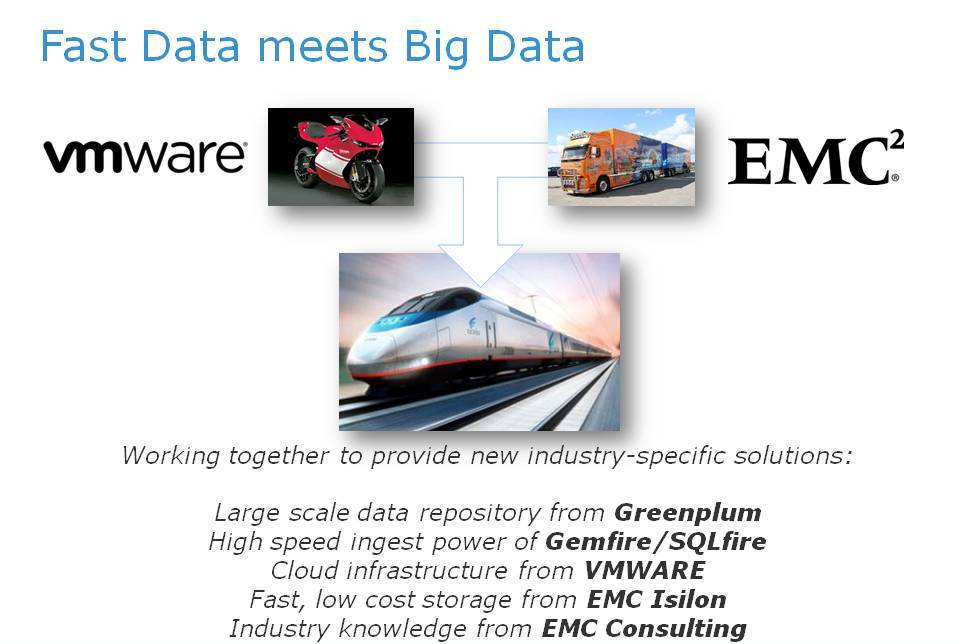
Our innovative solutions for Communications Service Providers leverage complimentary products from business units across EMC.
- Greenplum capabilities for analytics for structured and unstructured data are a key building block.
- Gemfire/SQLfire products ingest data from multiple disparate sources and perform immediate in-memory analytics.
- VMware virtualization capabilities allow the solution to scale up rapidly.
- Fast, low cost storage from Isilon houses the billions of events generated by the network.
- Wrapped around these foundational elements are the consultants from EMC Professional Services who configure the solution for a Service Provider based on years of industry experience.
What we have recognized is that centralize, behemoth data warehouses are going the way of the dinosaur. For the purpose of big data analysis, they are too massive, too rigid and too far removed from the “moment of business impact.” EMC’s approach is built on the same trends that revolutionized telecommunications networks and computing networks: Move analytics and decision-making to the edge of the network.
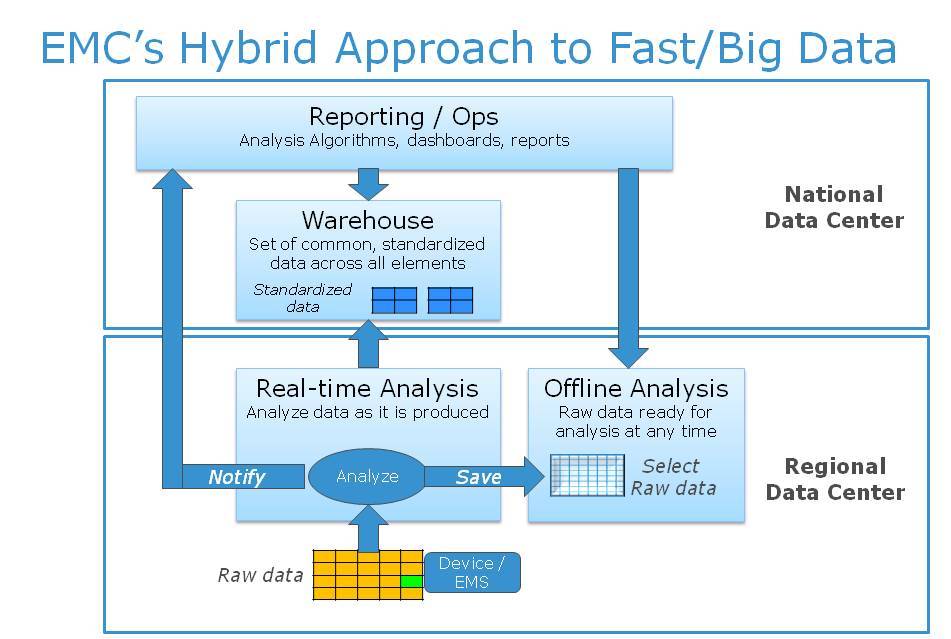
The above approach takes analytics and decisioning and stands it on head! Instead of delays and costs to ship data to a central national data center, business-impacting analytics and decision-making are performed in real-time, at the point just between the ‘network’ and the ‘IT analytics’ system.
Keep your current data warehouse if you like – no need to change. Like most dinosaurs, it can be around for a while, reliably doing the things it has done well in the past. But don’t expect it to be a nimble decathlon athlete, who is conditioned to excel at and have the stamina for 10 different demanding events over 2 days.
How does this approach fit in? Like a glove!
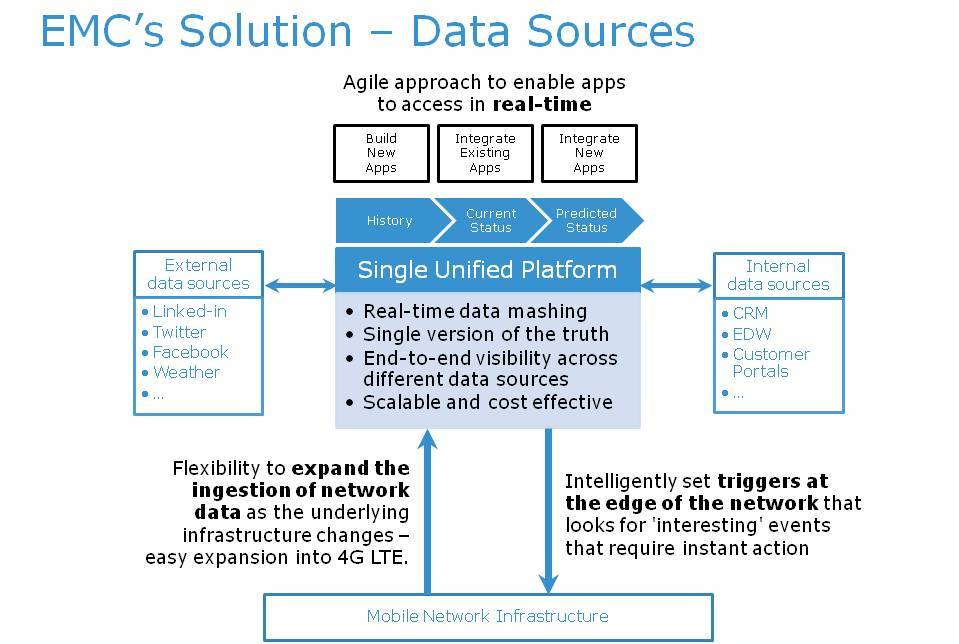
With pre-built interfaces to support typical service provider needs (like CDRs, probes, etc.) plus social media, the configuration is straightforward. This approach enables each service provider concentrate their efforts on the important stuff: determining the algorithms to extract value for their specific customers.
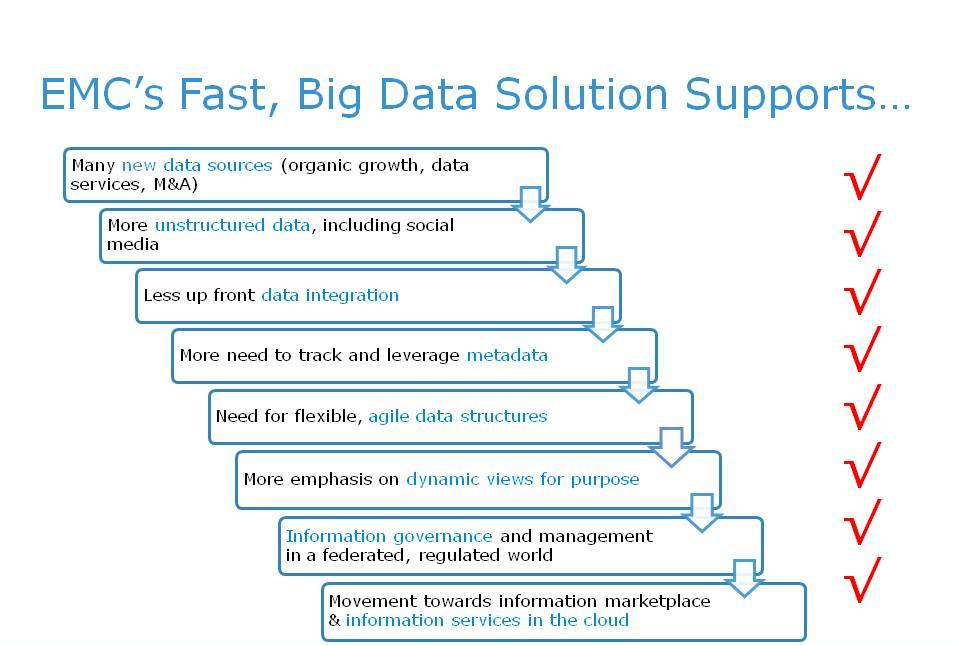
And with EMC’s proven industry consultants, we rapidly provide the service provider the ability to develop differentiated services for new revenue, reduce operating costs and make networks more efficient, and protect current revenue streams.
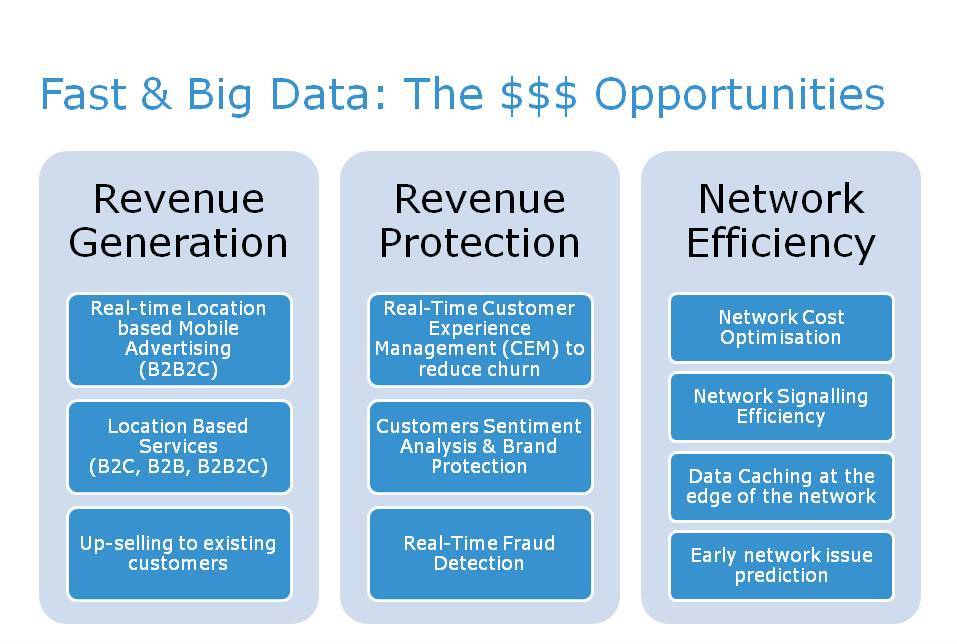
In closing, here is a technology reality check. The best quote of the conference came from an executive of Corning Glass, discussing challenges to Fiber-to-the-Home deployments: “Fiber itself is no longer a costly barrier to deployment. Fiber costs about $8 per kilometer – this is less than dental floss and toilet paper.“
Now, if we could only say that in a few years about big data. Stay tuned!
NEXT UP: More on Big Data for Service Providers – A Case Study
I hope you will join me and will pass on the link to your friends and networks. Please subscribe, send me feedback, and check back soon for the next installment. If nothing else, I promise my personal International Travel tips will be extremely useful!
Travel Tip of the Day: Global Entry reduces mandatory connection times at US ports of entry … a.k.a., yet another reason to apply for a Global Entry card!
How many times have you booked flights back to the US from a foreign destination – only to be told that the mandatory connection time from an inbound international carrier to a US domestic flight is 2 (or even 2 ½) hours?
Case & point: I’m flying from Sao Paulo, Brazil to JFK on the TAM day flight scheduled to arrive at 5:20pm. For my connection, there is a flight departing New York’s JFK at 7:10pm bound for Washington D.C.’s Dulles arriving at 8:25pm. Since I live 10 short minutes from Dulles airport, this itinerary gives me just enough time to make it home for an important family event that evening. Perfect!
“No you can’t!” my travel agent says. “This is not a legal airline connection. JFK requires 2 ½ hours to clear US passport control, customs and change terminals.” She states I have to take the flight departing JFK at 8pm, arriving Dulles at 9:30pm – missing the family event. “But wait,” I say, “I have the secret to quickly make the ’illegal’ connection legal … Global Entry!”
Global Entry may very well be the best Frequent Traveler program ever created. Please see my earlier blogs for additional details on how to apply. In short, it requires a $100 fee (waived if you have an American Express Platinum card), a 20-page online application, background checks plus a personal interview with the ever-popular agents of the Department of Homeland Security. Oh yes, and fingerprint scans. But it is worth it!
So, I (figuratively) wave my passport at the travel agent on the phone and tell her, “I have Global Entry — I don’t wait in any passport lines.” (Instead, I swipe my passport thru an automated kiosk reader which also reads my fingerprints.) I also tell her, “I never check bags.” So I am thru the passport and customs lines in about 5 minutes or less. This leaves plenty of time for the train between terminals as well as another security check.
Global Access works at every major US international airport. It also gives you the added benefit of access to TSA’s superfast Pre-Check security line to eliminate taking off shoes, removing liquids, etc. on domestic flights. As for my travel agent … she gave in, defeated, and booked my preferred itinerary. And, happily, I made it home in time for that important family event.
As your trusted travel advisor, this is my final plea, get Global Access. Your family will thank you!